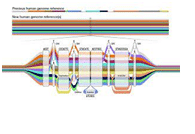Pangenome Reference Map
News: A Pangenome Reference Map has been developed utilising the genomes of 47 anonymous individuals, mostly from Africa but also from the Caribbean, the Americas, East Asia, and Europe (19 men and 28 women), according to a recent study published in the journal Nature.
Scientists utilise a reference genome or reference map, which is similar to a standard map, when they sequence and analyse new genomes.
It acts as a reference for contrasting and comprehending the variations between the recently sequenced genome and the reference genome.
Significant scientific progress was made in 2001 with the creation of the first reference genome.
It aided in the identification of genes linked to disease, the understanding of the genetics of conditions like cancer, and the development of new diagnostic procedures.
But it wasn’t flawless and had drawbacks.
In contrast to the prior linear reference genome, the pangenome is shown as a graph.
The pangenome’s chromosomes can be visualised as nodes on a bamboo stem.
The sections of sequences represented by these nodes are the same for all 47 individuals. The length differences between the internodes between the nodes show genetic variances among people with various ancestries.
Researchers employed a technique known as long-read DNA sequencing to produce precise, lengthy DNA strands in order to construct comprehensive and continuous maps of the chromosomes for the pangenome project.




